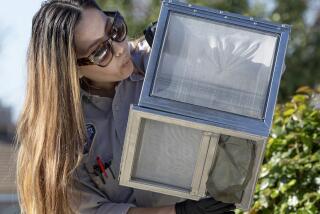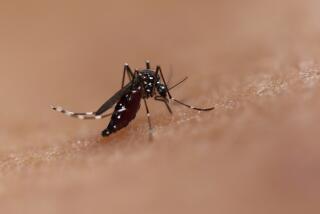Flesh Germ Patient Gains : Medicine: The athlete, treated for tissue-eating bacteria, may be released from hospital in a week. Ventura County woman has a similar infection.
For Bernard Donner, the whole thing began with an innocent-looking pimple on his thigh.
What followed, however, was a bout with a deadly tissue-eating bacteria that spread up to his waist and down to his ankle, almost killing him.
At a news conference Friday at the Sherman Oaks Hospital and Burn Center where Donner has been hospitalized, the 35-year-old Santa Barbara triathlete said that even as the disease began dissolving much of the flesh of his left leg, he had no idea what was going on.
“It was never bigger than a quarter,” he said, describing what the wound looked like from the outside in its early stages. “There was never any outrageous growth or flesh deterioration. It was a little bump. It never occurred to me that within 24 hours, I could have been dead.”
Dr. Richard Grossman, Donner’s physician, told the news conference that about 85% of the skin grafts Donner has been given have taken hold, and there will be at least one more skin graft surgery early next week. Donner could be released by next weekend, Grossman said.
Even as Donner continued to recover, however, a similar infection struck a Ventura County woman on Friday.
Guadalupe Polido, 63, entered Santa Paula Memorial Hospital Sunday complaining of a fever, nausea and a pimple on her left thigh, family members said. By Friday, the pimple had grown into an open sore stretching from her groin to her knee.
It was identified as Group B streptococcus, a relative of the Group A streptococcus that infected Donner. They are fast-acting, potentially deadly strains of a common germ that ordinarily causes little worse than a sore throat.
Polido was taken Friday to Los Robles Regional Medical Center in Thousand Oaks and placed in a pressurized oxygen chamber--as Donner was earlier in Sherman Oaks--because oxygen combats the bacteria. She was in critical condition Friday.
“What we’re doing here (with the oxygen chamber) is not only treating the patient, but we are preserving the tissue, so that she won’t have to undergo amputation,” said Dr. J.B. Wilmeth, the internal medicine specialist supervising her treatment.
Although Donner’s case--blamed on germs that entered his body through a shaving cut--attracted widespread news media attention, public health officials say it is extremely difficult to get the infection, and urge the public not to worry about catching it themselves.
“There’s no reason to be paranoid about it,” said Ventura County Public Health Officer Gary Feldman. “Germs are ubiquitous. Every surface on the planet is covered with microorganisms.”
Doctors say that most Group A streptococcus infections cause nothing more serious than strep throat, which afflicts many thousands of people, especially school children, each year. But for the past five years, scientists have noted the reappearance of the dangerous Group A strain, which was commoner in the early part of the century but almost disappeared in the 1940s.
The infection that Donner and Polido suffered is called “necrotizing fasciitis,” because it kills--necrotizes--the fascia, the tissue that binds skin to muscle. It received widespread press attention when at least seven people became infected with it in Gloucestershire, England, this spring. Eventually, 12 deaths were blamed on the disease throughout Great Britain.
In the United States, the federal Centers for Disease Control and Prevention estimates that in 1990, the last year in which it has figures, there were 10,000 to 15,000 severe cases of Group A strep, resulting in 2,000 to 3,000 deaths.
Of those, 500 to 1,500 included necrotizing fasciitis.
Medical authorities say that 30% to 50% of stricken patients die, in part because the disease moves so swiftly that symptoms can be difficult to detect in time to get the antibiotic and oxygen treatment needed to halt it before it reaches a vital organ.
For Donner, who became ill July 3, it was only after his mother--a nurse--guessed there might be a connection between her son’s lethargy and the small lesion on his leg that Donner was taken to the hospital.
“He was so lethargic, so weak,” his mother, Marianne Donner, said at the news conference, which was also attended by Bernard Donner’s wife and father. “I knew it must have been something more than flu, that it must have been some deep-seated infection. I could tell it was something more than you could see on the surface.”
First at a hospital in Santa Barbara, then at the Sherman Oaks hospital, doctors cut away dead tissue from his leg in an area that eventually grew to a cavity roughly 24 inches long, six inches wide and four inches deep, Grossman said. The cavity begins near Donner’s groin area, wraps around his knee, and ends at his ankle, said Grossman, who is medical director of the hospital’s burn center.
On Friday, Donner, who was propped up on a gurney with a blanket wrapped around his legs, said the infection first appeared as a pimple that resembled an ingrown hair. He said besides a touch of nausea, the infection then caused little pain.
It is believed he acquired the infection during a bicycle ride, when the bacteria entered his body through a cut caused by shaving his legs, a common practice for competitive cyclists.
Donner, a self-described fitness fanatic, vowed to resume exercising as soon as he can.
“My concern is, ‘I’ve been two weeks off my bike . . . how out of shape am I?’ ” he said. “I can lift my leg, and if I can lift my leg, you can rest assured that I will be back out in the water, and out on the bike very soon.”
Grossman said Donner might be capable of a light jog in two or three weeks.
The hospital gave Donner a $500 check to help defray medical expenses not covered by insurance. The family has set up a trust fund in Donner’s name at Santa Barbara Bank & Trust.
Times special correspondent Phyllis Jordan contributed to this story.






